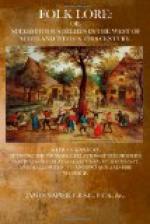“They’ve ta’en
the bride to the bridal bed,
To loose her snood nae mind
they had.
‘I’ll
loose it,’ quo John.”
On the morning after some of the married women of the neighbourhood met in the young wife’s house and put on her the curtch or closs cap (mutch), a token of the marriage state. In my young days unmarried women went with the head uncovered; but after marriage, never were seen without a cap. On the morning after marriage the best man and maid breakfasted with the young couple, after which they spent the day in the country, or if they lived in the country, they went to town for a change. Weddings were invariably celebrated on a Friday,—the reason for this preference being, as is supposed, that Friday was the day dedicated by the Norsemen to the goddess, Friga, the bestower of joy and happiness. The wedding day being Friday, the walking-day was a Saturday; and on Sunday the young couple, with their best man and best maid, attended church in the forenoon, and took a walk in the afternoon, then spent the evening in the house of one of their parents, the meeting there being closed by family worship, and a pious advice to the young couple to practise this in their own house.
If the bride had been courted by other sweethearts than he who was now her husband, there was a fear that those discarded suitors might entertain unkindly feelings towards her, and that their evil wishes might supernaturally influence her, and affect her first-born. This evil result was sought to be averted by the bride wearing a sixpence in her left shoe till she was kirked; but should the bride have made a vow to any other, and broken it, this wearing of the sixpence did not prevent the evil consequences from falling upon her first-born. Many instances were currently quoted




